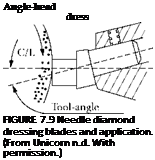The wear of single-point diamonds in profile dressing leads to problems with changing dress conditions because of the increasing cross section of the flat generated. The introduction of synthetic needle diamonds provides a solution in the form of a constant cross section. This type of tool has seen increasing usage as a replacement for higher quality single points. They are used both as a single stone but also more commonly as a blade tool with up to four stones in a row. When specifying the diamond stone size, bd is assumed to be the width of the diamond. This will vary somewhat based on the orientation of the stones, which will also affect finish.
Few guidelines have been published for the use of stationary tools for generating profiles on the wheel face. The Winterthur Company [Winterthur 1998] recommends that 0.6-mm stones be used for abrasive grit sizes <80/100#, and 0.8-mm stones for coarser wheels with an overlap ratio, Ud, value of 4. The number of stones used is dependent on the wheel diameter and width. Typically two stones are used for wheels <4 in., three stones for <20 in., and four stones for >20 in. The Noritake Company [Noritake n. d.] gave the following recommendations based on wheel surface area and wheel grit size (Table 7.3).
By offsetting the position of the stones, it is possible to use this type of blade dresser for dressing simple profiles such as angle-head wheels. The tool should be prelapped to the appropriate angle to limit break-in times.
|
TABLE 7.3 Recommendations for Stationary Dressing Tools Using Needle Diamonds
|
bd

 |
For normal recommendations 70% of the blade width should be below the C/line of the wheel.
